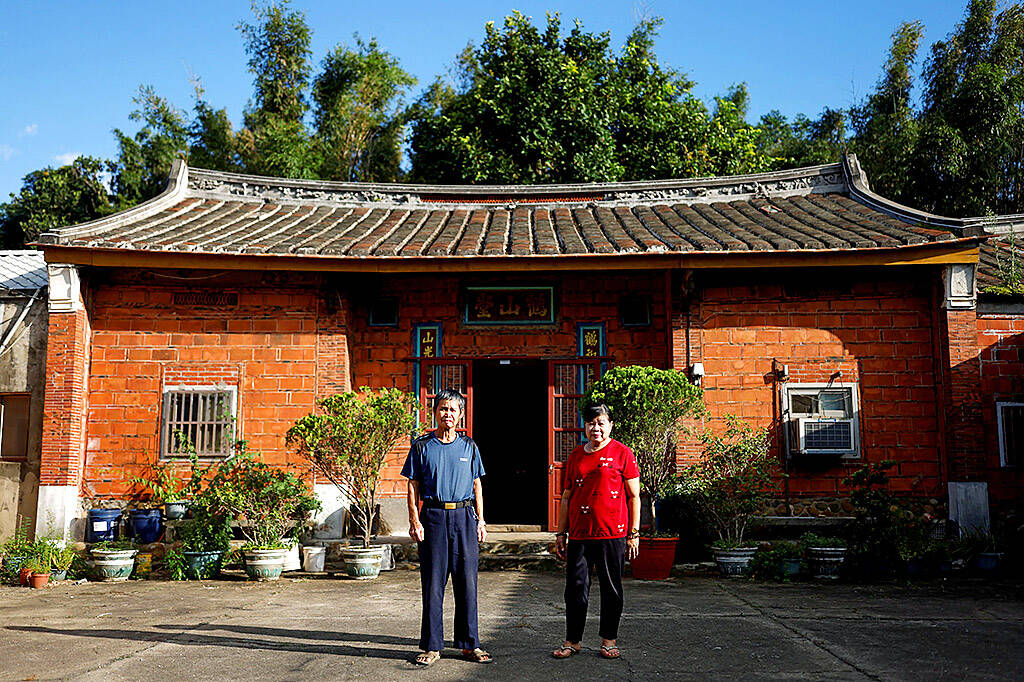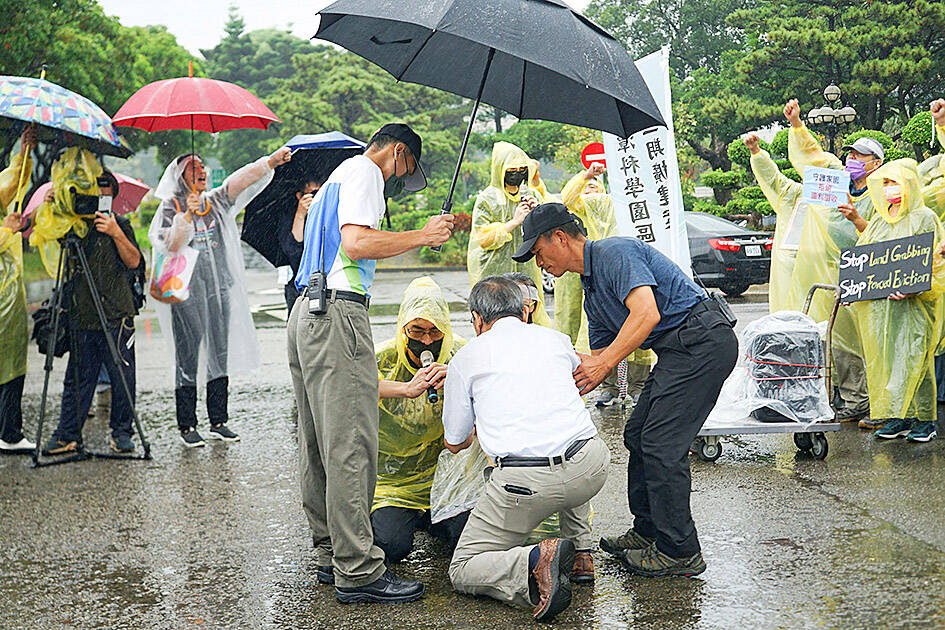Wearing rain ponchos and holding photos of their ancestral temples near Hsinchu, Taiwan’s semiconductor capital, 40 residents braved lashing winds in early last month to protest plans to take their rural land for cutting-edge chip production.
Two weeks later, Taiwan Semiconductor Manufacturing (TSMC), the world’s largest contract chipmaker, dropped plans to build a factory as part of the science park expansion in the bucolic Longtan district nearby — a development that heartened protesters and laid bare one of Taiwan’s increasingly fraught “five shortages.”
If the land crunch on the densely populated and mountainous island pushes TSMC to shift more production outside Taiwan — countries such as the US, Japan and Germany have offered it billions in incentives to do so — it could weaken the backbone of Taiwan’s economy, analysts say.

Photo: Reuters
“TSMC’s expansion in Taiwan has strategic significance for Taiwan’s economy and national security,” Minister of Economic Affairs Wang Mei-hua (王美花) told reporters after the announcement by TSMC, known on the island as “the sacred mountain protecting the country.”
Last year, Taiwan’s chip industry generated NT$4.837 trillion (US$150.27 billion) in revenue, nearly half of which came from TSMC, compared with Taiwan’s GDP of NT$22.667 trillion (US$704.21 billion). The sector employs 327,000 people and creates 704,000 jobs indirectly, according to the ministry.
With TSMC making most of the world’s advanced chips, which power everything from Apple’s iPhones to Nvidia’s AI data centres, Taiwan is scrambling to find land for the industry and cement its position as a critical node in the global tech supply chain.

Photo: Reuters
“Taiwan’s limited land and limited energy have always created a lot of pressure,” GlobalWafers CEO Doris Hsu (徐秀蘭) told reporters. “Besides TSMC, all tech companies — when they want to expand in Taiwan — have to consider land and whether residents in the area would support the industry being there.”
‘OUR ROOTS’
In July, at the first hearing for the proposed expansion, activists unfurled a “stop land pillage” banner and Hsu Shih-jung (徐世榮), a land economics professor at National Chengchi University, shouted his objections.

Photo: Reuters
“Taiwanese society has become a stratified society,” he said. “Rich people, the semiconductor industry, bigwigs — they can own land, they can plunder land. Us ordinary folks — prepare for eviction at any moment.”
Standing in an overflowing three-story hall in Longtan, Hsinchu Science Park Administration officials emphasized that they would provide fair compensation and pointed to the NT$600-650 billion worth of two-nanometer and below chips that would be produced annually and the 5,900 jobs that would be created.
“It was like they were drawing a big pie, but that pie was not for us,” said resident Chen Ting-yen, 39, who attended the hearing.
Chen, a restaurant and food delivery worker, and her multi-generational household live in a small house built by her father-in-law Wei Hsin-hsi. Next door is their family’s ancestral temple and graves.
“Our earliest ancestors who came to Taiwan — you want me to dig them up?” she said.
“These are our roots,” Chen said. “Roots cannot be moved.”
The Liao family’s ancestral temple also falls within the expansion area. Hundreds of relatives from across the island gather there during Lunar New Year and other festivals.
“Our whole family would be scattered,” if the temple is torn down, said Liao Chen-nan, 75.
‘FIVE SHORTAGES’
The chip industry has long complained about Taiwan’s “five shortages:” land, water, energy, labor and talent. The sector’s rapid growth in recent years, which has sent prices of industrial land soaring, is further testing the nation’s ability to support its prized chipmakers.
After protests, including one outside the presidential office, TSMC said it “respects the local community and regulatory authorities” and will work with the government to find suitable land elsewhere.
“There are many options and we do not expect any impact on our plan to grow in Taiwan,” the company said in a statement.
The government — determined to keep its crown jewel’s most advanced technology at home — has said it will provide alternative options.
Available land is “absolutely sufficient” to meet the industry’s needs, the economic ministry said, adding that there are already 426 hectares for new semiconductor factories in central and southern Taiwan’s science parks.
The Longtan expansion had proposed acquiring 159 more hectares in the north, where TSMC and many chip companies are based. The government is required to compensate landowners at market value.
Although TSMC has encountered opposition from residents and environmental groups before, its economic heft as Asia’s most valuable company has allowed it to keep expanding. It has repeatedly vowed to remain “rooted” in Taiwan.
Considering the island’s resource constraints, however, TSMC must also expand abroad, senior vice president Cliff Hou (侯永清) said this year.
In December, the company more than tripled its planned investment at its new Arizona plant to US$40 billion.
Taiwan still accounts for 90 percent of TSMC’s production, including its most advanced chips.
“If it really becomes impossible for TSMC to build factories in Taiwan and it moves abroad, the impact on Taiwan’s entire economy would not just be from the lack of land now, but from the entire industry starting to move abroad in the coming years,” Isaiah Research analyst Lucy Chen said, referring to the robust chip supply chain that developed alongside TSMC.
The science park administration, which had noted that Hsinchu and Longtan are running out of space to create advanced chips, said it would proceed with the expansion for other companies.
Residents have continued to protest, calling for the project to be axed altogether, while politicians from other cities have been vying for TMSC’s advanced factory.
Chen Chi-mai (陳其邁), mayor of Kaohsiung, where TSMC is building a 2-nanometre factory, told reporters that his southern city is equipped for more chip production.
“Opportunities are reserved for those who are prepared,” he said.

Wooden houses wedged between concrete, crumbling brick facades with roofs gaping to the sky, and tiled art deco buildings down narrow alleyways: Taichung Central District’s (中區) aging architecture reveals both the allure and reality of the old downtown. From Indigenous settlement to capital under Qing Dynasty rule through to Japanese colonization, Taichung’s Central District holds a long and layered history. The bygone beauty of its streets once earned it the nickname “Little Kyoto.” Since the late eighties, however, the shifting of economic and government centers westward signaled a gradual decline in the area’s evolving fortunes. With the regeneration of the once

Even by the standards of Ukraine’s International Legion, which comprises volunteers from over 55 countries, Han has an unusual backstory. Born in Taichung, he grew up in Costa Rica — then one of Taiwan’s diplomatic allies — where a relative worked for the embassy. After attending an American international high school in San Jose, Costa Rica’s capital, Han — who prefers to use only his given name for OPSEC (operations security) reasons — moved to the US in his teens. He attended Penn State University before returning to Taiwan to work in the semiconductor industry in Kaohsiung, where he

On May 2, Chinese Nationalist Party (KMT) Chairman Eric Chu (朱立倫), at a meeting in support of Taipei city councilors at party headquarters, compared President William Lai (賴清德) to Hitler. Chu claimed that unlike any other democracy worldwide in history, no other leader was rooting out opposing parties like Lai and the Democratic Progressive Party (DPP). That his statements are wildly inaccurate was not the point. It was a rallying cry, not a history lesson. This was intentional to provoke the international diplomatic community into a response, which was promptly provided. Both the German and Israeli offices issued statements on Facebook

Perched on Thailand’s border with Myanmar, Arunothai is a dusty crossroads town, a nowheresville that could be the setting of some Southeast Asian spaghetti Western. Its main street is the final, dead-end section of the two-lane highway from Chiang Mai, Thailand’s second largest city 120kms south, and the heart of the kingdom’s mountainous north. At the town boundary, a Chinese-style arch capped with dragons also bears Thai script declaring fealty to Bangkok’s royal family: “Long live the King!” Further on, Chinese lanterns line the main street, and on the hillsides, courtyard homes sit among warrens of narrow, winding alleyways and